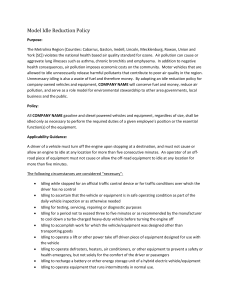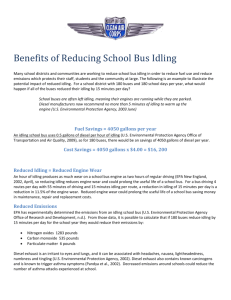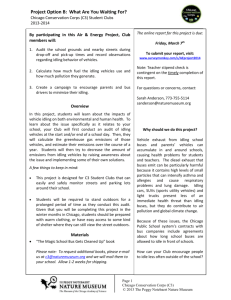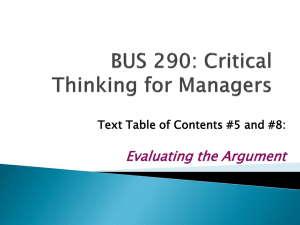1 Provided by: Natural Resources Canada Idle
advertisement
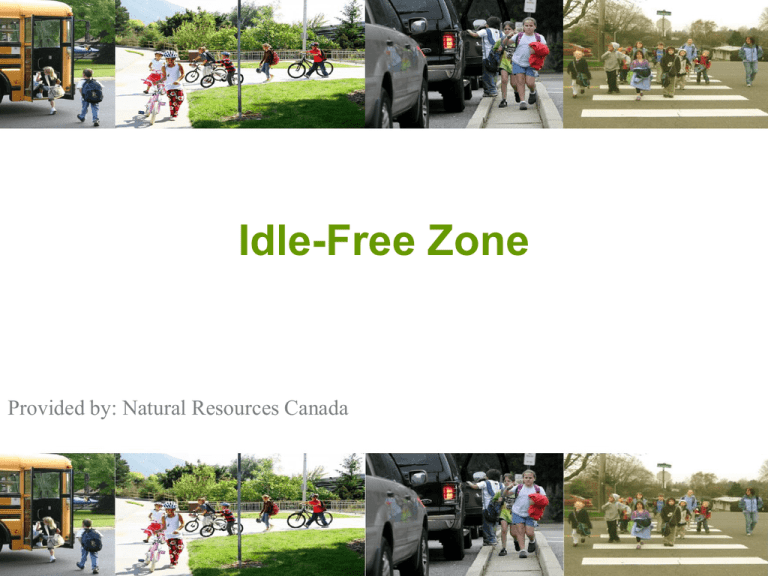
Idle-Free Zone Provided by: Natural Resources Canada Overview Part 1 - Understanding the Issues • Idling Behaviour • Idling Emissions and Related impacts • Idling Myths Part 2 – Taking Action • Individuals, businesses, municipalities, community organizations, schools Part 3 - Summary Vehicle Use in Canada • The transportation sector is responsible for 27 percent of GHG emissions in Canada • 19 million light-duty vehicles on the road • Almost one vehicle for every two Canadians • More than 300 billion kilometres driven per year • Poor decisions and bad habits contribute to fuel waste Why Do Canadians Idle? Most common reasons for idling in summer and winter: • Doing an errand • Stopping to talk to an acquaintance or friend • Using restaurant drive-throughs or stopping for take-out food • Waiting to get gas • Stopping to use a cellular phone • Warming up a vehicle • Waiting for someone How Much Do Canadians Idle? • Eight minutes a day in the peak of winter • 75 million minutes of idling per day nationally • Reduced idling in the summer – 46 million minutes per day Why Idling is a Problem Unecessary vehicle idling: • Wastes a lot of fuel – and money • Depletes a valuable non-renewable resource • Needlessly increases GHGs that contribute to climate change • Savings potential of $630 million per year nationally Impacts of Climate Change • Increasing levels of GHGs are trapping heat in the atmosphere • Global warming triggers changes in climate • GHG emissions can magnify the effects of air pollution • Affects air quality and health • We can all take steps to reduce GHGs Impact of Idling on Emissions Scenario 1 No Idling Scenario 2 Idling LEAVE POINT of ORIGIN Start engine Elevated CACs + GHGs Start engine Elevated CACs + GHGs DRIVE to DESTINATION CACs + GHGs CACs + GHGs WAIT at DESTINATION No Idling Turn engine off No CACs, No GHGs Start engine Briefly elevated CACs + GHGs Idling Engine idling CACs + GHGs Engine idling CACs + GHGs DRIVE AWAY CACs + GHGs CACs + GHGs • No substantial difference in CACs between scenarios 1 and 2 • Scenario 1 always generates less GHGs than scenario 2 Dispelling the Myths Idling Myth #1– The Engine should be warmed Up Before Driving In reality: • Excessive idling is not a good way to warm up a vehicle • The best way to warm up an engine is to drive it • 60 seconds of idling is enough warm-up time Dispelling the Myths Idling Myth #2 – Shutting Off and Restarting Your Vehicle is Costly because it is Hard on the Starter and Battery In reality: • Fuel costs savings offset wear and tear on the battery and starter after 60 seconds • 10-plus seconds of idling uses more fuel than restarting the engine Available Resources • Check out the Idle-Free Zone Web site – www.idling.gc.ca • Online resources can help you build a campaign • Facts and figures, ready-to-use graphics, survey tools and more • Find out how other communities are taking action Five-Step Action Plan Practice the easy Five-Step Action Plan: 1) Avoid unnecessary idling – if parked for more than 60 seconds, turn off the engine 2) Reduce warm-up idling – 60 seconds is enough (provided windows are defrosted) 3) Use a remote car starter only 60 seconds before you leave 4) Use a block heater to pre-warm the engine in winter 5) Become an advocate in your home, neighbourhood, school or workplace What Individuals Can Do to Take Action • Get informed – visit the Idle-Free Zone at www.idling.gc.ca • Contact municipal and school officials and local mall managers • Recommend an idling campaign to your community association What Businesses Can Do to Take Action at the Workplace • Organize a workplace idle-free campaign • Create “idle-free zones” in drop-off/pick-up spots and loading docks • Implement in-house practices and policies to reduce idling • See what other businesses are doing – fleetsmart.gc.ca • Support local initiatives What Municipal Governments Can Do to Take Action • • • • • • • Familiarize yourself with the issues Research what is being done elsewhere Investigate the scope of the problem - “idling hot spots” Look at your operations – adopt best practices Consider a mix of initiatives (outreach, by-laws) Partner with others Use free on-line resources to build a campaign What Community Groups Can Do to Take Action • Collaborate with municipalities and others to reduce idling • Gather the facts by surveying and monitoring • Organize events • Launch community awareness and public outreach campaigns What Schools Can Do to Take Action • • • • • • Remember the rule – No Idling at School! Ask for a commitment Create a “No Idling Zone” Monitor results Make it part of the curriculum Learn more and visit The Idle Free Zone section for “Schools” Summary Unnecessary Idling: • • • • • Wastes fuel and money Depletes a non-renewable resource Contributes to climate change Progress is being made but more action is required Individual actions make a difference For More Information • Visit the Idle Free Zone Web site at www.idling.gc.ca • Insert your own Web address Insert Image of Choice or Logo
